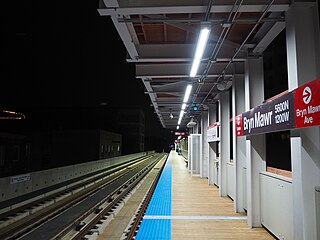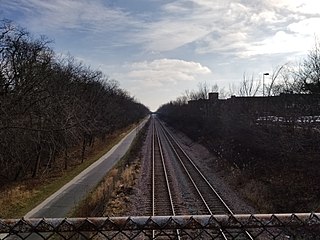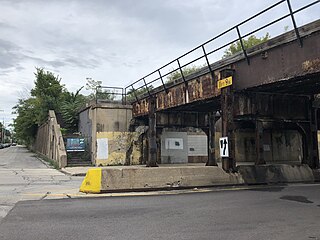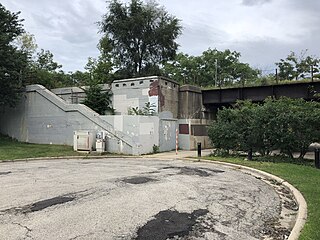
Wilmette is a village in Cook County, Illinois, United States. Bordering Lake Michigan, Kenilworth, Winnetka, Skokie, Northfield, Glenview, and Evanston, Illinois, it is located 14 miles (23 km) north of Chicago's downtown district. Wilmette had a population of 28,170 at the 2020 census. The first and only Baháʼí House of Worship in North America is located in Wilmette. Wilmette is also home to Central Elementary School and Romona Elementary School, both recent recipients of the National Blue Ribbon award bestowed by the U.S. Department of Education. According to the United States Census Bureau, the median household income in Wilmette was $183,750 in 2022.

The Yellow Line, also known as the Skokie Swift, is a branch of the Chicago "L" train system in Chicago, Illinois. The 4.7-mile (7.6 km) route runs from the Howard Terminal on the north side of Chicago, through the southern part of Evanston and to the Dempster Terminal in Skokie, Illinois, making one intermediate stop at Oakton Street in downtown Skokie.

The Purple Line of the Chicago "L" is a 3.9-mile (6.3 km) route on the northernmost section of the system. The service normally begins from Linden in Wilmette and ends at Howard on Chicago's north border, passing through the city of Evanston.

The North Shore consists of many affluent suburbs north of Chicago, Illinois, bordering the shores of Lake Michigan. These communities fall within suburban Cook County and Lake County. The North Shore's membership is often a topic of debate, and it includes some Chicago suburbs which do not border Lake Michigan. However, Lake Bluff, Lake Forest, Highwood, Highland Park, Deerfield, Glencoe, Northbrook, Northfield, Winnetka, Kenilworth, Wilmette, Golf, Glenview, Morton Grove, Niles, Skokie, Lincolnwood, and Evanston, are generally considered to be the main constituents of the North Shore. The North Shore is known for its affluence, high level of education, proximity to Chicago, and top-rated public schools. Lake County, Illinois is among the wealthiest counties in the U.S. and several of the wealthiest zip codes are there.

The Union Pacific North Line (UP-N) is a Metra line in the Chicago metropolitan area. It runs between Ogilvie Transportation Center and Kenosha, Wisconsin; however, most trains terminate in Waukegan, Illinois. Although Metra owns the rolling stock, the trains are operated and dispatched by the Union Pacific Railroad. This line was previously operated by the Chicago & North Western Railway before its merger with the Union Pacific Railroad, and was called the Chicago and North Western Milwaukee Division and then the Chicago & North Western/North Line before the C&NW was absorbed by Union Pacific in April 1995. It is the only Metra line that travels outside Illinois.

The Chicago North Shore and Milwaukee Railroad, also known as the North Shore Line, was an interurban railroad that operated passenger and freight service over an 88.9-mile (143.1 km) route between the Chicago Loop and downtown Milwaukee, as well as an 8.6-mile (13.8 km) branch line between the villages of Lake Bluff and Mundelein, Illinois. The North Shore Line also provided streetcar, city bus and motor coach services along its interurban route.

Evanston Davis Street is a commuter railroad station in downtown Evanston, Illinois. It is served by Metra's Union Pacific North Line with trains going south to Ogilvie Transportation Center in Chicago and as far north as Kenosha, Wisconsin. In Metra's zone-based fare system, Davis Street is in zone 2. As of 2018, Evanston Davis Street is the 12th busiest of Metra's 236 non-downtown stations, with an average of 1,876 weekday boardings. The station is next to the Davis station of the Chicago Transit Authority's Purple Line, where CTA and Pace buses terminate. Between the two stations is 909 Davis Street, a six-story building with a kiss-and-ride loop for car drop-off.

Bryn Mawr is an 'L' station on the CTA's Red Line. It is located at 1119 West Bryn Mawr Avenue in the Bryn Mawr Historic District of the Edgewater neighborhood of Chicago, Illinois. The adjacent stations are Thorndale, located about 1⁄2 mile (0.80 km) to the north, and Berwyn, about 3⁄8 mile (0.60 km) to the south. Four tracks typically pass through the station, but the two western tracks are currently out of service for reconstruction. Normally there is an island platform in the center of the tracks, but currently there is a single side platform which currently only serves southbound trains; Purple Line weekday rush hour express service pass through the station on the same tracks used by the Red Line but do not stop. The name "Bryn Mawr" comes from the SEPTA Regional Rail station located northwest of Philadelphia in the community of the same name. The name came to the area in the 1880s by Edgewater developer John Lewis Cochran, and is Welsh for "Big Hill."

The Green Bay Trail is a rails with trails built on the former Chicago North Shore and Milwaukee Railroad. It runs parallel to Metra's Union Pacific North Line for nearly nine miles from Wilmette, Illinois, to Highland Park, Illinois. It was originally a path used by various users between the Chicago area and the Green Bay, Wisconsin, area.

The Northwestern Elevated Railroad was the last of the privately constructed rapid transit lines to be built in Chicago. The line ran from the Loop in downtown Chicago north to Wilson Avenue in Chicago's Uptown neighborhood with a branch to Ravenswood and Albany Park that left the main line at Clark Street. The Ravenswood line is now operated as the Brown Line, while the Main Line is used by the Purple and Red Lines.

The North Side Main Line is a branch of the Chicago "L" system that is used by Red, Purple, and Brown Line trains. As of 2012, it is the network's busiest rail branch, serving an average of 123,229 passengers each weekday. The branch is 10.3 miles (16.6 km) long with a total of 21 stations, from Howard Street in Rogers Park down to Lake Street in Chicago's Loop. The branch serves the north side of the city 24 hours a day, seven days a week.

Dempster Street was a commuter railroad station on the Chicago and North Western Railway's Milwaukee Division, now the Union Pacific North Line. The station was located at Dempster Street and Sherman Avenue, in Evanston, Illinois. It was adjacent the CTA Purple Line's Dempster station.

Calvary was a commuter railroad station on the Chicago and North Western Railway's Milwaukee Division, today's Union Pacific North Line. The station was located at Mulford Street and Chicago Avenue, in Evanston, Illinois.

Peterson/Ridge station is a railroad station on the North Side of Chicago serving Metra's Union Pacific North Line. It is located at the intersection of West Peterson Avenue and North Ravenswood Avenue in Chicago's Edgewater community area. A groundbreaking ceremony for construction was held on November 1, 2021. Construction concluded and the station opened on May 20, 2024.

Lake Geneva station was an Amtrak intercity rail station in Zenda, Wisconsin. Commuter service to Zenda was operated by the Milwaukee Road from 1900 to 1982. Lake Geneva station was added as an infill station on the Lake Country Limited on June 15, 2000, to serve the Lake Geneva resort area. The Lake Country Limited was never successful, and service ended on September 23, 2001. Commuter service with a stop near Zenda was studied in 2001, but found to only be marginally feasible.
Kenmore was a commuter railroad station on the Chicago and North Western Railway's Milwaukee Division, now the Union Pacific North Line. The station was located on Ravenswood Avenue between Granville and Thome Avenues, in Chicago's Edgewater neighborhood. Kenmore opened in 1887 or 1888, and closed on December 1, 1958, as part of an effort by the Chicago and North Western to close twenty two stations within the city of Chicago and the close-in suburbs.
Ravenswood–Wilson was a commuter railroad station on the Chicago and North Western Railway's Milwaukee Division, now the Union Pacific North Line. The station was located at Wilson and Ravenswood Avenues, in Chicago's Ravenswood neighborhood.

The Chicago and Evanston Railroad (C&E), later the Evanston Division of Milwaukee Road, was a rail line in Chicago, Evanston, and Wilmette, Illinois. The northern half of the line became part of the North Side main line and the Evanston branch on the Chicago "L".


















